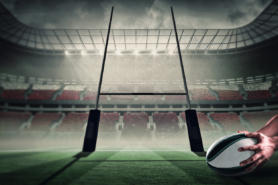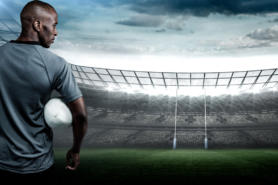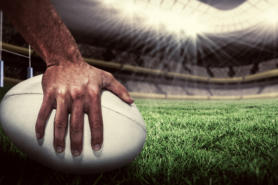Protecting the Rugby World Cup brand
As Rugby World Cup reaches an exciting conclusion, the winner on the field will be crowned – but how do brands win off the field and how do trade marks help.

The Rugby World Cup (RWC) is one of the largest sporting events in the world. For the first time, it is taking place in Asia which presents a new opportunity for brands.
As the final approaches, Claire Jones, a Senior Chartered Trade Mark Attorney at HGF looks at some of the intellectual property issues raised by the tournament for us.
Sponsors

World Rugby’s worldwide partners, together with official suppliers, licensees and broadcasters, will have made significant investments to be associated with the tournament.
To protect this investment, World Rugby’s partners will all expect certain levels of protection and enforcement – backed up by the registered trade mark rights they all inevitably own.
There are six partners: Emirates, Heineken, Land Rover, Mastercard, Société Générale and DHL, together with six official sponsors: Canon, Toto, Secom, Taisho Pharmaceutical, Mitsubishi Estate and NEC.
There are also several tournament suppliers, including Gilbert and Canterbury.
The guidelines, terms and conditions set by World Rugby protect the investment and exclusive rights granted to the sponsors, partners and licensees of the tournament. These will include (amongst others) monitoring and action plans on counterfeit merchandise, ambush marketing campaigns and social media activity.
The world cup logo

Yes, the new logo for the 2019 Rugby World Cup is a registered trade mark. It is owned by Rugby World Cup Limited (part of World Rugby) who also own trade mark registrations in Japan (and internationally) for the words Rugby World Cup, World Rugby and the Web Ellis Cup design, amongst others.
As stated on the Rugby World Cup website “Furthermore, all rights in the tournament names, main trophies, company names, trade names, logos, product packaging and designs of RWC or official sponsors, licensees, suppliers, or other third-party products or services, belong exclusively to RWC or such third-party, as applicable, or their respective owners, and are protected from reproduction, imitation, dilution or confusing or misleading uses under national and international laws, as applicable.
Together with the terms on the website, Rugby World Cup Ltd also provides media guidelines, which set out what can and cannot be used.
For example, the use of the official event trade mark is encouraged and appreciated and available purely for use in editorial (non-commercial) articles and news coverage – so we have no problem using it in this blog.
However, it is explicitly set out that the event trade mark cannot be used for any commercial purposes, including the sale, advertisement or promotion of any goods or services – such use is reserved for the authorised, official sponsors, partners and suppliers.
Several companies and local businesses around Japan might be keen to take advantage of the event and raise their commercial profiles, but they will need to consider the risk of appearing to endorse the RWC commercially without express permission.
Because ‘Rugby World Cup’ is a registered trade mark, references to the Rugby World Cup should not be made unless you or your business is an official or authorised entity. Accordingly:
- Do not use wording in promotional materials such as ‘Rugby World Cup’ or ‘RWC 2019’ – this includes use in hashtags
- Do not use imagery, such as the Web Ellis Trophy or the ‘filleted fish’ logo
- Do not use phrases, slogans or team names associated with the tournament
- Do not imply any association with the tournament, website, broadcaster or RWC Ltd
- Do not use any colour schemes like those used by RWC Ltd; these may not be registered, but there will be unregistered rights and copyright issues
- Be aware of the rights owned by RWC and their sponsors, affiliates and licensees and avoid using identical or similar wording/logos
Ambush marketing

Ambush marketing is an intentional effort by a non-sponsor of an event to create the impression of being an official sponsor, without authorisation and more importantly, without paying sponsorship fees.
Such campaigns can confuse the public and take unfair advantage of the public and media interest in an event to obtain exposure for their own products.
Japan has not enacted specific legislation to combat ambush marketing, unlike at the London 2012 Olympics.
The Japanese Rugby Union instead elected to rely on existing trade mark, competition and copyright legislation to combat the practice during the tournament.
There are harsh penalties under Japanese law for breaches; as an example, infringers of a trade mark right can face imprisonment with work for up to 10 years and/or a fine not exceeding 10m yen (around £75,000).
Relying on existing legislation can also remove some of the criticisms of anti-ambush marketing regulations where it is argued that they limit freedom of speech and are anti-competitive.
Non-official sponsors
There are numerous ways of promoting or advertising a brand without falling foul of ambush marketing, although it can be a fine line. Some previous examples:
- Nike – London 2012: Nike launched a global TV campaign “FIND YOUR GREATNESS” featuring everyday athletes competing in places around the world called London.
- PaddyPower – London 2012: Paddy Power executed a billboard campaign across London train stations proclaiming that they were the “Official sponsor of the largest athletics event in London this year”. Then went on to clarify that they meant in France, where they had hired out fields in London, France and put on school sports day games, such as egg and spoon races.
- O2 – RWC 2015: O2 gave away 50,000 branded t-shirts to England fans to wear during matches with the “wear the rose” campaign.
- Guinness – RWC 2015: Heineken may have had a 500-metre advertising exclusion zone around Twickenham stadium, but the exclusion zone did not extend to the main train station and the pubs in the area where Guinness used chalk stencils on zebra crossings reminding people to order their “Guinness”.
The main dilemma for the organisers is that legal action itself can make the news and with social media, can result in significant negative publicity.
Even if the infringer is in the wrong and the organisers in the right, by the time any formal legal proceedings have made it to a decision, the public will have already cast judgment.
It is a difficult balancing act between protecting rights and preventing infringers from being able to ride on the back of any free publicity generated.
There is no ‘one size fits all’ approach for marketing, and whilst litigation enforcement should be a last resort, it should also act as a deterrent.
A balance will need to be struck to calibrate the rights of the sponsors and official partners with the local businesses, residents and fans engaging in the tournament.
Official merchandise

Official merchandise is available throughout the tournament and unofficial merchandise will be carefully monitored. A guideline on identifying official merchandise can be viewed here.
Summary
With every major sporting event such as the Rugby World Cup, there will be a stranglehold over commercial usage of the tournament.
Breaches of intellectual property can give rise to significant claims, including trade mark and copyright infringement, potential criminal offences and damages.
The general test can always be: does your advertising or branding of products and services infer a relationship such that consumers would assume that you are an official sport or licensee? If in doubt, leave it out.


